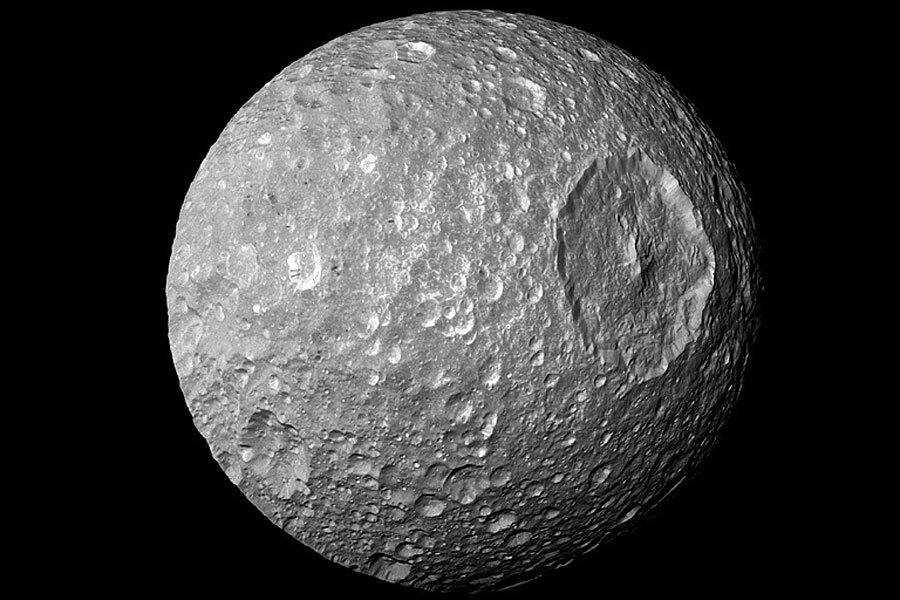That's no moon. It's a – wait, actually it is a moon. Never mind.
Loading...
There's something strange going on below the surface of Saturn's Death Star-looking moon Mimas, a new study suggests.
Mimas' rotation and its orbit around Saturn make the moon look like it's rocking and back forth and oscillating similar to the way a pendulum swings. The rocking motion is called libration, and it's commonly observed in moons that are influenced by the gravity from neighboring planets. However, using images of the moon captured by the Cassini spacecraft, Radwan Tajeddine, a research associate at Cornell University, discovered that the satellite's libration was much more exaggerated in one spot than predicted. Heexpects it must be caused by the moon's weird interior.
"We're very excited about this measurement because it may indicate much about the satellite's insides," Tajeddine said in a statement. "Nature is essentially allowing us to do the same thing that a child does when she shakes a wrapped gift in hopes of figuring out what's hidden inside." [See photos of Mimas, Saturn's Death Star Moon]
Feel the libration
Astronomers have long been using the rotation and orbit of celestial bodies to guess what their interiors might be like. Most of the rocking is explained by the interacting forces from Mimas' rotation and orbit, but one libration was much larger than expected.
Tajeddine and the team tested five different models of what Mimas might look like below the surface to see which one could explain the exaggerated rocking. They quickly ruled out the possibility that Mimas has a uniform interior, an interior with two different layers or an abnormal mass under the moon's 88-mile-long (142 kilometers) crater that makes it look like the Death Star from the "Star Wars" franchise.
However, the last two models could both explain Mimas' extreme libration. One idea is that the moon has an elongated, oval-shaped core. This elongation might have happened as the moon formed under the push and pull of Saturn's rings. The teeter tottering could also come from a subsurface ocean, similar to the one onJupiter's moon Europa.
While it's still a possibility, Tajeddine thinks the subsurface ocean is an unlikely explanation. Astronomers have not observed any evidence of liquid water on Mimas, unlike some of Saturn's other moons. The heat radiating from the core escapes through the moon's ice-covered shell and would cause any subsurface ocean that existed to quickly freeze.
3D Mimas map
Mimas is the smallest and closest of Saturn's main eight moons. Its giant crater covers almost one-third of the moon's icy surface.
For the past 10 years,the Cassini space probe has been collecting data on Mimas, Saturn and the ringed wonder's other natural satellites. The Imaging Science Subsystem (ISS) onboard Cassini is a two-camera system that captures ultraviolet and infrared images of Saturn and its moons.
Tajeddine and a team of researchers sifted through dozens of images captured by ISS and created a 3D map of the moon from the photos to study how Mimas spins and orbits Saturn.
The new research was published this week in the journal Science.
Follow Kelly Dickerson on Twitter. Follow us @Spacedotcom, Facebook or Google+. Originally published on Space.com.
- 10 Real Alien Worlds That Resemble 'Star Wars' Planets
- Incredible NASA Photos Show Saturn's Rings and Clouds
- Saturn Quiz: How Well Do You Know the Ringed Planet?
Copyright 2014 SPACE.com, a TechMediaNetwork company. All rights reserved. This material may not be published, broadcast, rewritten or redistributed.







